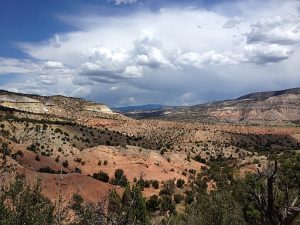i. Foreword: NM OER Consortium’s Faculty Guide
Chapter Subtopics
The New Mexico Open Educational Resources (OER) Consortium seeks to enhance the educational experiences of higher education students and faculty in the state. The mission of the NM OER Consortium includes connecting New Mexico educators to promote textbook affordability for the state’s higher education students.
Student Success
For students, the consortium will seek to create more equitable circumstances for students who cannot afford textbooks because students who do not have access to textbooks are at an educational disadvantage (Florida Virtual Campus 2022; Jenkins et. al 2020). The 2022 Florida Student Survey found that 53% of the 13,000 students surveyed did not purchase a required textbook due to cost. Because of textbook costs, 43% of students surveyed took fewer courses and 24% reported dropping a course (Florida Virtual Campus 2022).
Jhangiani and Jhangiani (2017) found that the cost of textbooks influenced students’ course enrollment, persistence, as well as registration and withdrawal from courses. For example, some textbooks cost more than one credit hour of instruction at UNM, often reaching $200-$300 for a single book. At these rates, even adoption of OER in a single class of 200 students has the potential to save students $40,000-$60,000 per semester.
Faculty Support
The consortium seeks to provide higher education faculty with the support they need to adopt low and no-cost textbook and class material solutions for their courses when it aligns with their instructional objectives and academic freedom. OER and other alternative materials can be a more cost-effective and up-to-date option for faculty, which allows them to provide their students with high-quality materials to their students minus the financial burden.
Beyond zero student cost, OER can give faculty more flexibility and control over their course materials because open licenses allow faculty to adapt and tailor their curriculum to the needs and goals of their students, courses, and pedagogy. Additionally, open materials afford faculty the opportunity to center marginalized perspectives and diversify their curriculum (Seiferle-Valencia, 2020).
To help reach this goal, the consortium will build on state investments in equitable education, including the NM Opportunity Scholarship, the NM Lottery Scholarship, State Bill 192, and the New Mexico General Education Curriculum.
New Mexico Context

With racial/ethnic minority populations in NM comprising 60% of adults and 74% of the children, NM is unique. Native Americans comprise nearly one in 10 residents of New Mexico, and the state land area is shared with 23 Tribal nations. According to the latest census data, New Mexico is listed as the state with the third highest poverty rate, with 19.1% of the population living below the poverty line. Open Educational Resources have the potential to greatly increase equity for New Mexico students seeking higher education.
Open Textbooks Pilot Grant
The University of New Mexico (UNM) was selected as one of the recipients of the federal Open Textbook Grant for nearly $2.125 million dollars, enabling the creation of the textbook you are currently reading. With this grant funding, UNM will create the New Mexico Open Educational Resources (NMOER) Consortium to help faculty across the state to adopt open access materials. Currently the consortium is comprised of 1) three Hispanic-Serving Institutions, the University of New Mexico, Central New Mexico Community College, and Santa Fe Community College; 2) The University of New Mexico Press; 3) a workforce advisory board that includes Workforce Connections, Bureau of Business and Economic Research, University of New Mexico Hospital, and the New Mexico Black Leadership Council.
This faculty guidebook seeks to inform New Mexico educators about how to integrate OER curriculum into their courses using accessible, inclusive, and credible processes that we will refine and assess over time with stakeholder input.
License, Attribution, and Works Cited
Openly Licensed Materials
Foreword: NM OER Consortium’s Faculty Guide was collected and organized by Jennifer Jordan and is licensed CC: BY 4.0 international.
Jhangiani, R. S., & Jhangiani, S. (2017). Investigating the perceptions, use, and impact of open textbooks: A survey of post-secondary students in British Columbia. The International Review of Research in Open and Distributed Learning, 18(4).
Rights Restricted Materials
Florida Virtual Campus. (2022). 2022 student textbook and course materials survey.
Seiferle-Valencia, M. (2020). It’s not (just) about the cost: Academic libraries and intentionally engaged OER for social justice. Library Trends, 69(2),pp. 469-487.

